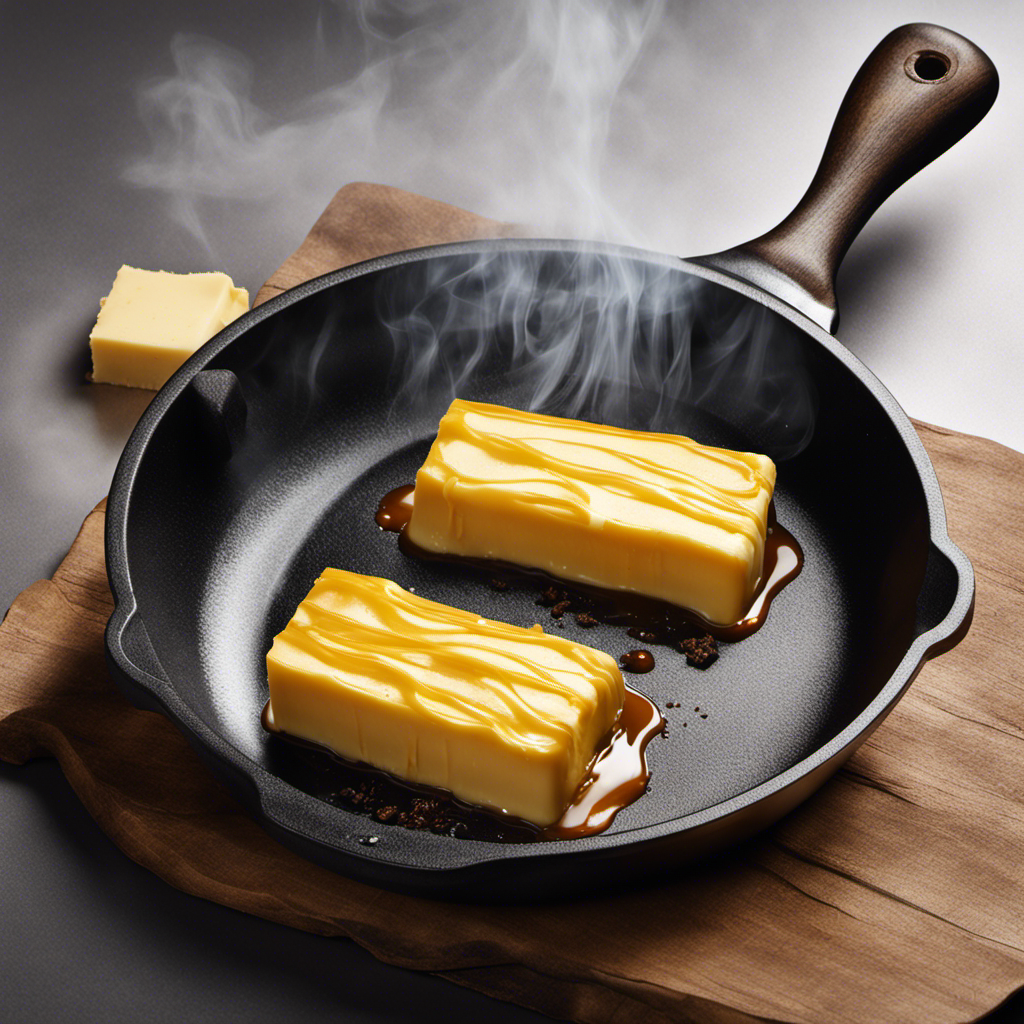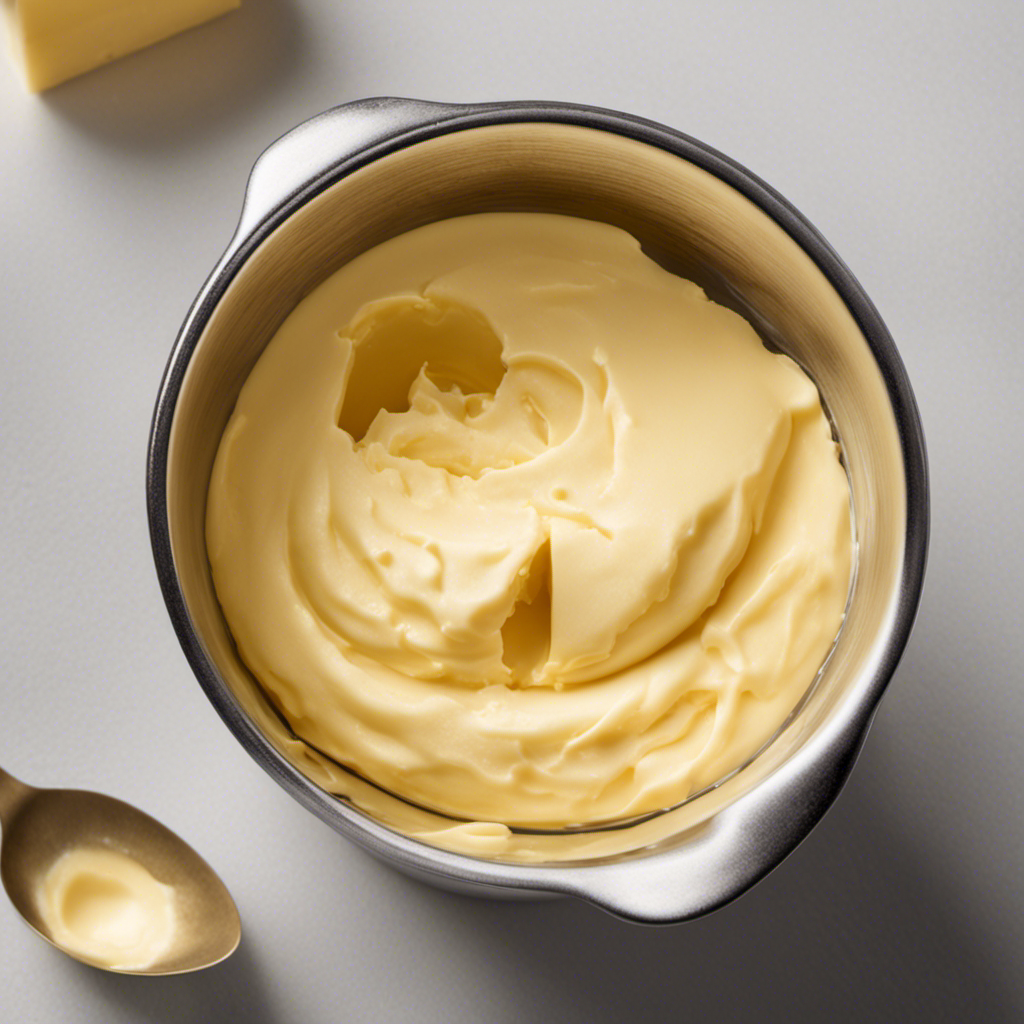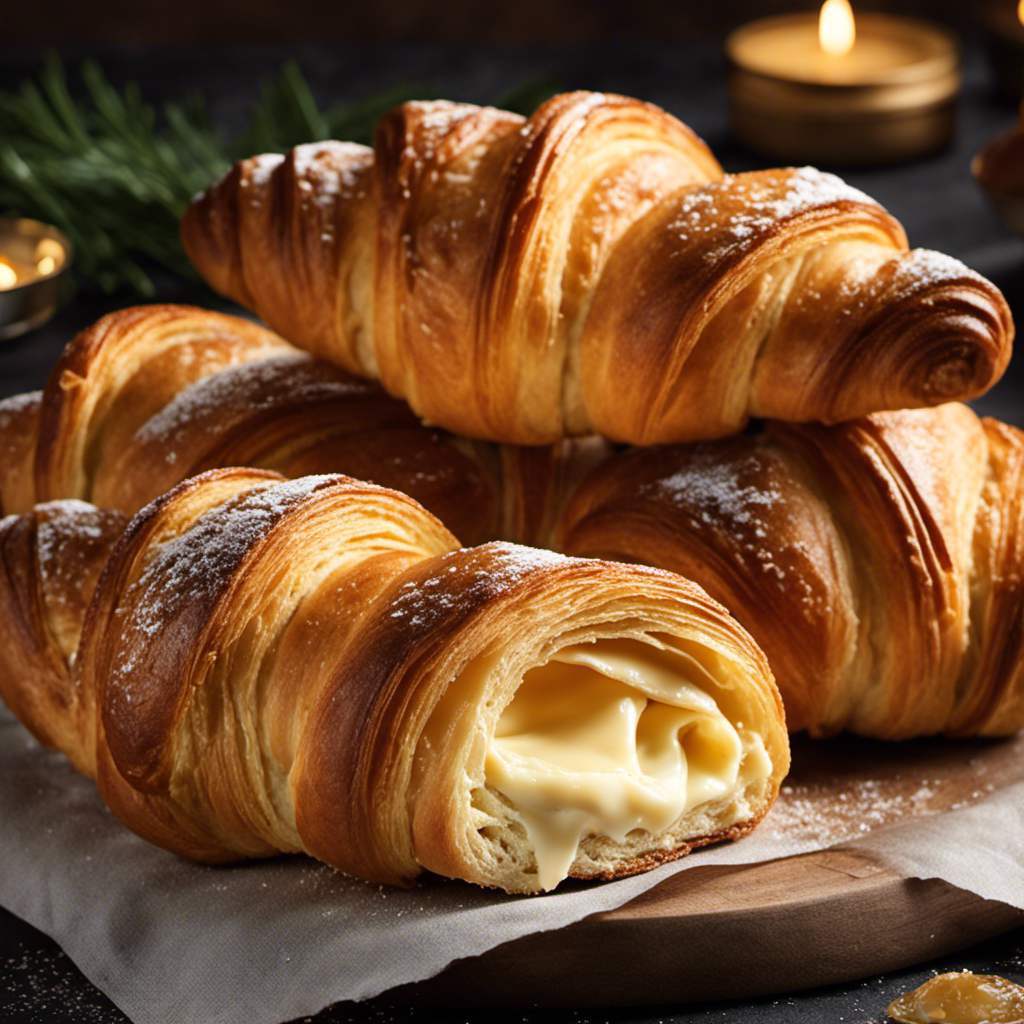Were you aware that butter can burn at a certain temperature? Absolutely! For those of us who enjoy exploring and creating in the kitchen, the science of cooking holds a special intrigue. Knowing the specific temperature at which butter can burn is crucial for enhancing our cooking experiments.
In this article, we will delve into the factors that affect butter’s burning point, explore the smoke point of butter, compare it to margarine, and share some tips and tricks to rescue burnt butter.
So, let’s dive into the world of butter burning and uncover its secrets!
Key Takeaways
- Butter undergoes chemical reactions when heated, resulting in the evaporation of water content and the caramelization of milk solids.
- Monitoring temperature is crucial to prevent burning, as high heat or prolonged cooking can cause the milk solids to burn and create bitterness.
- Factors such as moisture content in butter, cooking time, and pan materials can affect the burning point of butter.
- The smoke point of butter is the temperature at which it starts to burn and release smoke, and exceeding this point can lead to combustion and the formation of harmful compounds.
The Science Behind Butter Burning
If you don’t pay attention to the temperature, you might end up burning your butter while cooking.
The butter browning process is an interesting chemical reaction that occurs when butter is exposed to high heat.
When butter is heated, its milk solids and proteins undergo a series of reactions.
At first, the water content in butter evaporates, causing the butter to sizzle.
As the temperature continues to rise, the milk solids begin to caramelize, creating a rich, nutty flavor and a golden-brown color.
However, if the heat is too high or the butter is left unattended for too long, the milk solids can burn, resulting in a bitter taste and a dark brown or black color.
It is important to monitor the temperature closely and adjust it accordingly to prevent butter from burning.
Factors Affecting Butter’s Burning Point
One factor that affects when butter burns is the type of pan you use. Different pans conduct heat differently, which can impact the temperature at which butter burns. Here are three key factors to consider when it comes to butter burning:
-
Moisture content: Butter contains a small percentage of water, and this moisture can affect its burning point. Higher moisture levels in butter can lower its smoke point, making it more prone to burning at lower temperatures.
-
Cooking time: The longer you cook butter, the more likely it is to burn. As butter cooks, the milk solids in it begin to brown and eventually burn. Therefore, the longer you expose butter to heat, the higher the chances of it burning.
-
Pan material: The type of pan you use can significantly impact the burning point of butter. Non-stick pans, for example, tend to have lower heat conductivity, which can cause butter to burn at lower temperatures compared to pans with higher heat conductivity.
Understanding these factors will help us better comprehend the concept of the smoke point of butter in the subsequent section.
Understanding Smoke Point of Butter
When it comes to cooking with butter, understanding its smoke point is essential. The smoke point refers to the temperature at which butter starts to burn and release smoke. Knowing this information allows me to cook with butter without it becoming burnt and imparting an unpleasant taste to my dishes.
However, in cases where burnt butter does occur, it’s important to explore alternatives to salvage the recipe and avoid wasting ingredients.
Butter’s Smoke Point
You should be aware that butter’s smoke point is the temperature at which it starts to burn and release smoke. Understanding this is crucial to prevent any dangers and ensure safe cooking practices. Here are three key points to help you navigate butter’s smoke point:
-
Importance of knowing the smoke point: Knowing the smoke point of butter is essential because exceeding it can lead to the dangers of combustion. When butter burns, it releases harmful compounds and a pungent odor, affecting the taste and quality of your dish.
-
Preventing combustion: To avoid butter from reaching its smoke point, it’s crucial to use low to medium heat when cooking with butter. Adding a small amount of oil or clarified butter can also raise the smoke point, allowing you to cook at higher temperatures without the risk of burning.
-
Alternative cooking fats: If you need to cook at higher temperatures, using oils with higher smoke points, such as canola or coconut oil, is a safer option. These oils can withstand higher temperatures before reaching their smoke point, minimizing the risk of combustion and ensuring a successful cooking experience.
Cooking With Burnt Butter
Cooking with burnt butter can add a unique and nutty flavor to your dishes. When butter is heated to a high temperature, it begins to brown and develop a rich, toasty taste. This technique can be used to enhance the flavor of both sweet and savory dishes. The key is to carefully monitor the butter as it cooks, as it can quickly go from browned to burnt.
Below is a table highlighting different cooking techniques for utilizing burnt butter in various dishes:
| Dish | Cooking Technique | Flavor Enhancement |
|---|---|---|
| Pasta | Browned Butter Sauce | Nutty, caramelized notes |
| Vegetables | Sautéing | Deep, earthy flavor |
| Baked Goods | Brown Butter Frosting | Rich, decadent taste |
| Seafood | Pan-Frying | Buttery, slightly smoky |
Alternatives to Burnt Butter?
If you’re looking for alternatives to burnt butter, there are other ingredients that can add a similar nutty and toasty flavor to your dishes. Here are three options to consider:
-
Ghee: Ghee is a clarified butter commonly used in Indian cuisine. It has a rich, deep flavor that is reminiscent of burnt butter. You can use it in the same way you would use regular butter, whether it’s for sautéing vegetables or spreading it on toast.
-
Toasted sesame oil: This oil is made from toasted sesame seeds and has a strong, nutty flavor. It can be drizzled over dishes like stir-fries or used as a finishing oil to add a delicious toasted note.
-
Nut oils: Walnut, almond, and hazelnut oils all have a naturally nutty taste that can mimic the flavor of burnt butter. These oils can be used in salad dressings, baking, or even drizzled over roasted vegetables for added depth of flavor.
Is Clarified Butter More Resistant to Burning
Clarified butter is known to be more resistant to burning than regular butter. This is because when butter is clarified, the milk solids and water are removed, leaving only the pure butterfat. This process increases the smoke point of the butter, making it less likely to burn at high temperatures.
The resistance of clarified butter to high heat is one of its main benefits in cooking. It can be used for sautéing, frying, and baking without the risk of burning and imparting a burnt taste to the dish. The higher smoke point also allows clarified butter to be used for longer cooking times without breaking down.
Now, let’s transition into the subsequent section about ‘butter vs. margarine: which burns faster’.
Butter Vs. Margarine: Which Burns Faster
When comparing the burning points of butter and margarine, it is important to consider their composition.
Butter, being a natural product made from cream, has a lower burning point compared to margarine, which is made from vegetable oils.
This difference in composition leads to a faster burning rate for butter as it contains a higher percentage of milk solids that can easily catch fire.
Burning Point Comparison
To compare the burning points of different fats, you can try heating them in a controlled environment and observing the results. This experiment allows you to witness the chemical reactions that occur when fats are exposed to high temperatures. By using temperature control, you can ensure that the fats are heated consistently and accurately.
Here are three key elements to consider when conducting this experiment:
-
Choose a variety of fats: Select a range of fats, such as butter, lard, and vegetable oil, to compare their burning points. This will provide a comprehensive understanding of how different fats react to heat.
-
Use a controlled environment: Conduct the experiment in a controlled setting, such as a laboratory or a well-ventilated kitchen. This will minimize external factors that could influence the results.
-
Observe and record: Pay close attention to the fats as they heat up. Observe any changes in color, texture, or odor. Record the temperature at which each fat starts to burn.
By comparing the burning points of different fats, we can gain valuable insights into their heat resistance and make informed choices when it comes to cooking and baking.
Now, let’s delve into the specific comparison of butter vs. margarine.
Butter Vs. Margarine
If you’re trying to decide between butter and margarine, it’s important to consider their differences in terms of taste and health benefits.
While butter is a classic choice with its rich and creamy flavor, margarine offers a range of butter alternatives that can suit different dietary needs.
One of the key health benefits of margarine is its lower saturated fat content compared to butter. Saturated fat has been linked to increased risk of heart disease, so choosing margarine can be a healthier option.
Additionally, margarine often contains plant sterols or stanols, which have been shown to help lower LDL cholesterol levels.
However, it’s important to note that not all margarines are created equal, so it’s essential to read labels and choose varieties that are trans fat-free and made from healthy oils such as olive or canola oil.
Faster Burning Rate
For a faster burning rate, try using margarine instead of butter in your recipes. Margarine contains a higher percentage of fats that have a lower smoke point compared to butter. This means that margarine will start to smoke at a lower temperature, resulting in a faster oxidation process.
Here are three reasons why margarine can lead to a faster burning rate:
-
Higher unsaturated fat content: Margarine typically contains more unsaturated fats than butter, which are more prone to oxidation. This increased level of unsaturated fats makes margarine more susceptible to smoking and burning.
-
Lower smoke point: The smoke point of margarine is usually lower than that of butter. This lower smoke point means that margarine will reach its smoking temperature more quickly, leading to a faster burning rate.
-
Processing techniques: Margarine undergoes manufacturing processes that may result in the production of compounds that are more prone to oxidation. These compounds can contribute to a faster burning rate when exposed to heat.
Understanding the factors that contribute to a faster burning rate when using margarine can help you make informed decisions when choosing between butter and margarine in your recipes.
Now, let’s explore the role of heat in butter browning.
The Role of Heat in Butter Browning
The temperature at which butter burns can vary depending on factors like the type of butter and the heat source used. Heat control plays a crucial role in the browning process of butter. When butter is heated, its milk solids undergo a series of chemical reactions, resulting in the formation of browned compounds that add depth and flavor to dishes. To better understand the relationship between heat and butter browning, let’s take a look at the following table:
| Type of Butter | Smoke Point (°F) | Burning Point (°F) |
|---|---|---|
| Unsalted | 350 | 400 |
| Salted | 350 | 375 |
| Clarified | 450 | 500 |
| Ghee | 485 | 520 |
| European | 350 | 400 |
Can Butter Burn at Room Temperature
I’ve always wondered about the burning point of butter and whether it can actually burn at room temperature.
It turns out that butter has a relatively low burning point compared to other cooking oils, around 350°F (175°C). This means that if left unattended, butter can potentially catch fire if exposed to high temperatures for an extended period of time.
To prevent butter combustion, it’s important to store it properly and avoid leaving it near heat sources or in direct sunlight.
Butter’s Burning Point
Be careful not to let your butter burn by keeping an eye on the temperature. The melting point of butter is around 90-95°F (32-35°C). Heating it beyond this temperature can have detrimental effects on its flavor.
Here are three important things to consider when it comes to the effects of heat on butter’s flavor:
-
Flavor degradation: When butter is subjected to high heat, the milk solids in it can start to brown and even burn, resulting in a bitter taste. This can significantly alter the flavor profile of your dish.
-
Loss of aroma: Heat can cause the volatile compounds responsible for butter’s unique aroma to evaporate. This can lead to a less fragrant and flavorful end result.
-
Smoky flavor: If butter is heated for too long or at too high a temperature, it can develop a smoky flavor due to the breakdown of its fatty acids. This can overpower the taste of your dish and leave an undesirable aftertaste.
Room Temp Dangers
To avoid any potential dangers, make sure you keep an eye on the room temperature of your ingredients.
Room temperature storage can be risky, especially for ingredients like butter. When stored at room temperature, butter is susceptible to oxidation, which can lead to an unpleasant taste and texture. Oxidation occurs when the fats in butter react with oxygen in the air, causing the butter to become rancid. The warmer the room temperature, the faster this process occurs.
It’s important to store butter in the refrigerator to slow down oxidation and extend its shelf life. If you prefer soft butter for spreading, you can always take out a small amount and leave it at room temperature for a short period of time. Just remember to return the remaining butter to the refrigerator promptly to avoid any potential risks.
Preventing Butter Combustion?
Make sure you keep an eye on the temperature of the pan when cooking with butter to prevent any combustion risks.
Butter, while a delicious and versatile ingredient, can pose a fire hazard if not handled properly.
Here are three key points to consider when it comes to preventing butter combustion:
-
Temperature control: Butter has a relatively low smoke point, around 350°F (175°C). It’s important to avoid heating the pan above this temperature to prevent the butter from burning and potentially catching fire.
-
Clarified butter: Clarifying butter removes the milk solids, which are the most combustible part of butter. This process increases the smoke point, making it less likely to ignite when exposed to high heat.
-
Proper storage: Storing butter in a cool place away from direct heat sources can help prevent it from becoming too soft or melting. This reduces the risk of accidental ignition when using butter in cooking.
Butter Burning: Culinary Tips and Tricks
Butter burns quickly if left unattended on high heat. As a culinary enthusiast, I have learned that mastering cooking techniques is essential for flavor enhancement.
When it comes to butter, it is crucial to understand its burning point. Butter has a low smoke point of around 350°F (175°C). This means that if you expose it to high temperatures for too long, it will start to smoke and eventually burn.
To prevent this, I recommend using clarified butter or ghee, which have higher smoke points. Alternatively, you can add a small amount of oil to the butter, as the oil will help raise the smoke point.
How to Rescue Burnt Butter
When butter burns, it can leave an unpleasant taste and smell in your dish. However, there are ways to rescue burnt butter and prevent butter combustion from happening in the first place. Here are three tips to help you in rescuing burnt butter:
-
Remove the burnt butter from heat immediately: As soon as you notice the butter starting to burn, take the pan off the heat source. This will prevent the burnt flavor from infusing further into your dish.
-
Transfer the remaining butter to a new pan: If the burnt bits are stuck to the bottom of the pan, carefully pour the remaining butter into a new pan, leaving the burnt residue behind. This will allow you to salvage the usable butter.
-
Add fresh butter or oil to mask the burnt taste: If the burnt flavor is still present in your dish, you can add a small amount of fresh butter or oil to help balance out the taste. This will help mask the unpleasant burnt notes.
Butter Burning in Different Cooking Methods
Different cooking methods can result in burnt butter, which can negatively impact the taste of your dish. Butter burning can occur at different cooking temperatures, depending on the method used.
For example, when sautéing or frying at high heat, butter can quickly reach its smoke point and burn. This can lead to a bitter and unpleasant taste. Additionally, the addition of spices can also affect butter burning. Some spices, such as paprika or chili powder, have a lower smoke point, causing the butter to burn more easily when combined with high heat.
It is important to be mindful of the cooking temperature and the spices used to prevent butter burning and maintain the desired flavor in your dishes.
Transitioning into the subsequent section about ‘butter burning: safety precautions and best practices’, it is crucial to understand how to avoid this issue altogether.
Butter Burning: Safety Precautions and Best Practices
To prevent burning, you should always monitor the heat level and avoid leaving your pan unattended while cooking with butter. Butter has a low smoke point, which means it can easily burn if exposed to high heat for too long. Here are three safety measures to prevent butter from burning:
-
Use a low to medium heat setting: When cooking with butter, it’s important to keep the heat at a moderate level. This ensures that the butter melts and cooks evenly without reaching its smoke point.
-
Clarify the butter: Clarified butter has a higher smoke point than regular butter. By removing the milk solids and water content from the butter, you can reduce the risk of burning and increase its heat tolerance.
-
Add oil or use a butter substitute: Mixing butter with a high smoke point oil like canola or vegetable oil can help increase its heat tolerance. Alternatively, you can use a butter substitute like ghee or margarine, which have higher smoke points than regular butter.
Frequently Asked Questions
How Does the Burning Point of Butter Compare to Other Cooking Oils?
When comparing the burning points of butter and olive oil, butter has a lower burning point. Burnt butter can negatively affect the taste of food, giving it a charred and bitter flavor.
Can Butter Burn if Left Unattended on the Stove?
Can butter catch fire on the stove? Leaving it unattended can lead to disaster. When butter is overheated, its milk solids can burn, creating a smoky and potentially harmful situation.
What Are the Signs That Butter Is Being Burned?
When butter is burned, it exhibits several signs such as a dark brown or black color, a strong and unpleasant smell, and a bitter taste. These effects on taste can greatly impact the overall flavor of a dish.
Is It Safe to Eat Butter That Has Been Burned?
Eating burned butter can have health risks due to the formation of harmful compounds. However, burned butter can still be used in culinary applications to add a smoky flavor, as long as it is not consumed in large amounts.
How Can I Prevent Butter From Burning When Cooking?
To cook with butter without it burning, I control the heat by starting with a low temperature and gradually increasing it. This ensures the butter melts evenly and doesn’t burn.
Conclusion
After delving into the science behind butter burning and exploring various factors that affect its burning point, it is clear that butter can be quite temperamental when exposed to high temperatures.
However, fear not, for there are ways to rescue burnt butter and prevent culinary disasters. By understanding the smoke point of butter and considering alternative options like clarified butter, we can navigate the fine line between golden perfection and a charred catastrophe.
So, remember to tread carefully, keep your temperatures in check, and let your butter dance gracefully in your culinary adventures.










